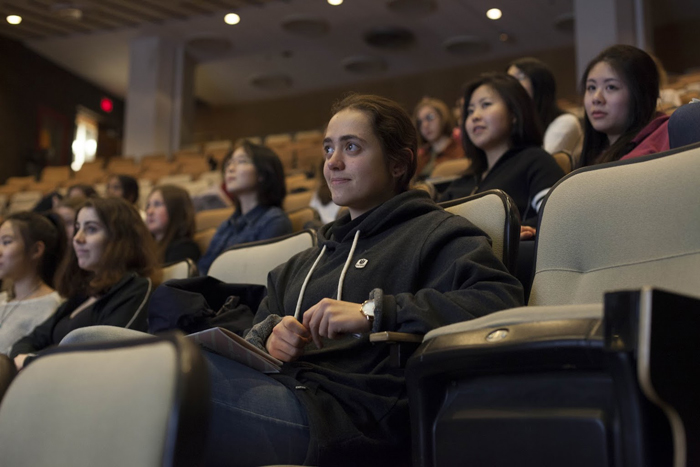A street artist, a professor, a tattoo artist, a videogame designer, and a curator all walk into a bar—or rather, a McGill University auditorium.
On Nov. 30, the McGill Students’ Visual Arts Society (MSVAS) presented “Art à la Mode: Keeping Art Current,” a Q&A discussion panel questioning visual art’s position in today’s world. The panel focused on how visual art has moved out of its traditional arena and has emerged in fields like technology, pop culture, and social justice movements.
Montreal is a hub for technology, style, and visual art. The MSVAS took advantage of all the city has to offer in curating their discussion panel, which featured some of Montreal’s most interesting art personalities. The panel consisted of Julia Skelly, McGill Department of Art History and Communication Studies Faculty Lecturer and feminist scholar; Rebecca Cohen-Palacios, videogame developer and co-founder of Pixelles, a non-profit organization for women in gaming; Fluke, a Montreal street artist; Robb Jamieson, the curator of Art Pop Montreal; and Katakankabin, a tattoo artist working at Minuit Dix Tattoo in the Mile End.
The discussion covered a wide range of experience and disciplines, exploring questions about their unique disciplines, how they define art, and how their distinct scenes have changed over time.
Each guest began by explaining their origin story, giving the audience more insight into the way they think about their own experience with visual art. Cohen-Palacios began her career as a website designer, until one day she saw an advertisement for a six-week intensive program for women interested in video game design. Two weeks after she graduated from the program, she interviewed at Ubisoft Montreal, and has been working there ever since. Fluke discussed his roots in the Montreal graffiti scene, and how his street art saved him from a life of homelessness. He explained that art for him began as a survival tool and blossomed into a career.
Though each speaker’s artistic roots are different, they share a common theme: Regardless of their niche, they each described visual art as their chosen medium for self-expression and social action. Fluke commented on his experience in the Montreal graffiti scene, explaining how for him, street art was a means of self-expression.
“It’s really about action,” Fluke said. “What causes a 16-year-old person to risk going to jail? Or [being] killed? There’s a social need to be acknowledged, to fight for space.”
Each speaker passionately emphasized this need to occupy space, to demand acknowledgement for themselves or others. Cohen-Palacios used the example of women in gaming. She explained that as resources for creating games become free to access, a more diverse population can create content. As more people enter the industry and producers become more representative of the general population, video games’ ability to have a social impact increases.
The speakers discussed the future of visual art as a vehicle for new voices in existing industries. Professor Skelly explained how she uses her platform to teach students about the social structures that surround modern art, and to critically examine how artists may be underrepresented due to race, gender, and sexuality.
“As an art historian, I am deeply uninterested in the question of money when it comes to art,” Skelly said. “I am thinking of the art I want to teach my students. Art allows me to write about things I find important.”
The speakers finished the panel by describing the future of visual art—a future in which they hope visual art can be used as a tool for both institutional and social change. In this vein, Cohen-Palacios highlighted the need for the video game industry to address the inequality between the number of women and men employed in the field.
MSVAS delivered a diverse and multifaceted panel. The questions were pertinent and created an active debate among their guests. Together, MSVAS and the speakers created a thought-provoking dialogue about modern art and the many ways it can be used as a social tool today, and as we move into the future.








